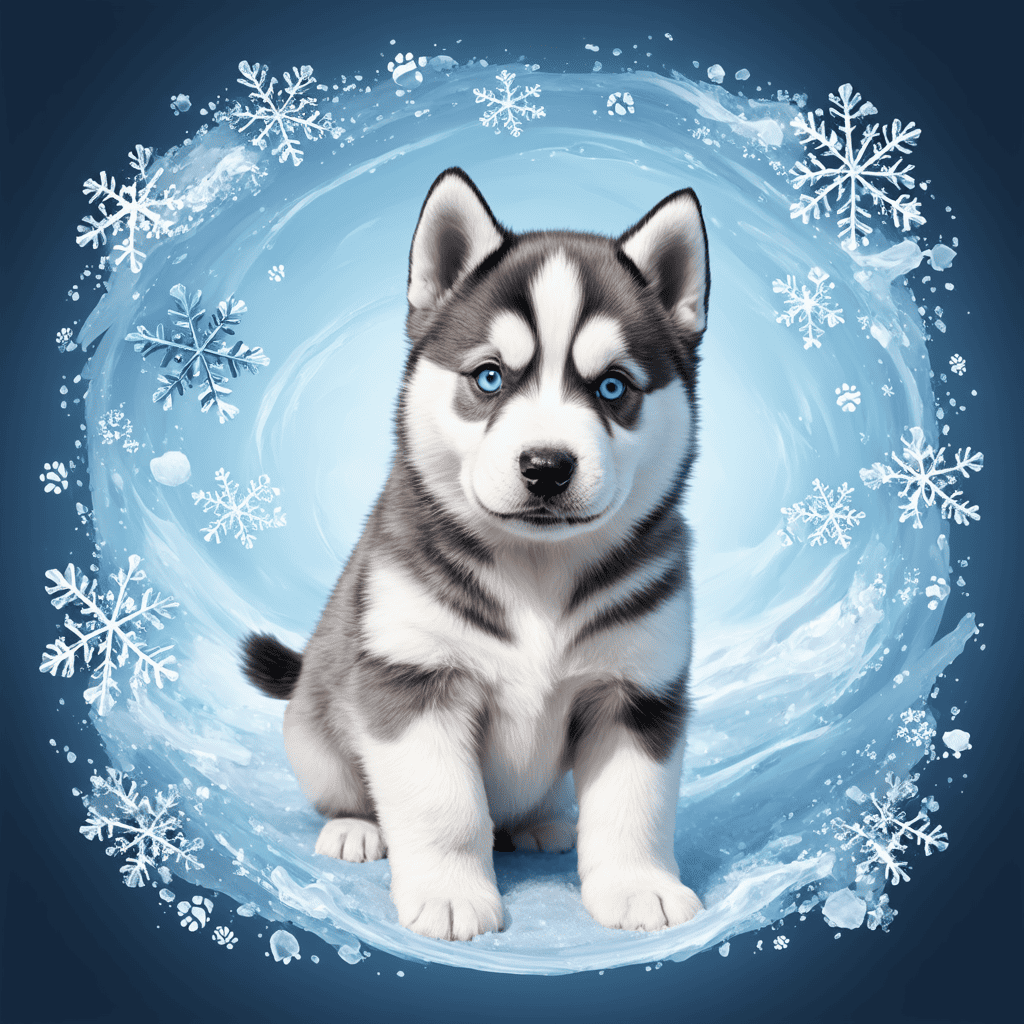Key Takeaways
- Cost Awareness: Siberian Husky puppies typically range from $600 to $1,500, with factors like lineage and breeder reputation influencing prices.
- High Energy Needs: Huskies require 1-2 hours of exercise daily to thrive, making them ideal for active families.
- Training Importance: Early socialization and training are crucial; positive reinforcement helps manage their independent nature.
- Shedding Management: Expect significant shedding, especially during seasonal changes; regular grooming is essential to maintain a clean home.
- Lifespan Insights: Siberian Huskies generally live between 12 to 15 years, with health care and diet playing key roles in longevity.
- Vocalization Traits: Huskies are known for their vocal nature; managing their communication habits is important for a peaceful home.
- Living Conditions: They thrive in homes with ample space and secure yards; climate control is necessary to keep them comfortable.
Welcome to our comprehensive guide on Siberian Husky puppies, where we delve into the essential insights you need to know before bringing one of these stunning dogs into your home. In this article, we will explore the various aspects of owning a Siberian Husky puppy, including the costs associated with purchasing one, the care requirements to keep them healthy and happy, and their expected lifespan. We will answer common questions such as, “How much is a Siberian Husky puppy?” and “Do Huskies shed a lot?” to help you make an informed decision. Additionally, we will evaluate whether a Siberian Husky is a good house dog and provide tips on managing their vocalization and shedding habits. Whether you’re considering a Red Siberian Husky puppy for sale or simply want to learn more about this captivating breed, our guide is designed to equip you with the knowledge you need for a successful journey with your new furry friend.
How much is a Siberian Husky puppy?
Understanding the cost of a Siberian Husky puppy is essential for prospective pet owners. The price can vary significantly based on several factors, including the puppy’s lineage, health screenings, and the breeder’s reputation. Typically, the cost of a Siberian Husky puppy ranges from $600 to $1,500 when purchased from a reputable breeder. However, puppies from champion bloodlines or those with rare coat colors may command higher prices, sometimes exceeding $2,000.
Additionally, potential owners should consider ongoing costs associated with Siberian Huskies, such as food, grooming, training, and veterinary care, which can significantly impact the overall investment in pet ownership. According to the American Kennel Club, proper training and socialization are crucial for this breed, known for its energetic and independent nature.
For those looking to adopt rather than purchase, local shelters and rescue organizations may have Siberian Huskies available for lower fees, often ranging from $150 to $500, which typically includes vaccinations and spaying/neutering. When considering the purchase of a Siberian Husky, it’s essential to research and select a responsible breeder who prioritizes the health and well-being of their dogs, ensuring that you are making a sound investment in a lifelong companion.
Factors influencing the cost of Siberian Husky puppies for sale
Several factors influence the cost of Siberian Husky puppies for sale. These include:
- Lineage: Puppies from champion bloodlines or those with show potential often come at a premium price.
- Health Screenings: Responsible breeders conduct health tests on their breeding dogs, which can affect the price of the puppies.
- Breeder Reputation: Well-established breeders with a history of producing healthy, well-socialized puppies may charge more.
- Location: Prices can vary by region, with some areas having higher demand and costs associated with pet ownership.
Understanding these factors can help you make an informed decision when looking for a Siberian Husky puppy. Always prioritize the health and temperament of the puppy over the price to ensure a happy and healthy addition to your family.

Is a Siberian Husky a Good House Dog?
Yes, a Siberian Husky can be a good house dog, but it requires a dedicated approach to training, exercise, and mental stimulation to ensure they thrive in a home environment. Here are key considerations:
- Energy Levels: Siberian Huskies are known for their high energy and endurance. They need at least 1-2 hours of vigorous exercise daily, which can include walks, runs, or playtime in a secure yard. Regular physical activity is crucial to prevent boredom and destructive behaviors.
- Training: Early socialization and obedience training are essential for Huskies. They are intelligent but can be independent and stubborn. Positive reinforcement techniques work best. Consistent training helps them adapt to household rules and reduces the likelihood of behavioral issues.
- Mental Stimulation: Huskies are highly intelligent and require mental challenges to stay engaged. Interactive toys, puzzle feeders, and training exercises can help keep their minds sharp. Engaging in activities like agility training or scent work can also be beneficial.
- Temperament: Huskies are known for their friendly and outgoing nature. They typically get along well with children and other pets, but their strong prey drive may lead them to chase smaller animals. Supervision is advised during playtime.
- Climate Considerations: Originally bred for cold climates, Huskies can struggle in extreme heat. Ensure they have access to shade and water during hot weather, and avoid strenuous exercise during peak temperatures.
- Living Space: While Huskies can adapt to living indoors, they thrive in homes with ample space to roam and play. A securely fenced yard is ideal for their safety and freedom.
- Health Considerations: Regular veterinary check-ups are essential to monitor for common health issues in Huskies, such as hip dysplasia and eye conditions. A balanced diet and regular exercise contribute to their overall well-being.
In summary, with the right training, exercise, and mental stimulation, a Siberian Husky can be a wonderful house dog. Their playful and affectionate nature can bring joy to a household, provided their needs are met. For more information on dog training and behavior, resources from the American Kennel Club (AKC) can be invaluable.
Evaluating the Temperament of Siberian Huskies
The temperament of a Siberian Husky is one of their most appealing traits. They are known for being friendly, outgoing, and social dogs. Here are some key aspects of their temperament:
- Affectionate Nature: Huskies are generally very affectionate with their families and enjoy spending time with people. They thrive on companionship and can be quite playful.
- Independence: While they are social, Huskies also have an independent streak. This can sometimes lead to stubbornness, making training a challenge if not approached correctly.
- Playfulness: Their playful demeanor makes them great companions for children and active families. They enjoy games and activities that stimulate both their body and mind.
- Vocalization: Huskies are known for their vocal nature. They may howl or “talk” to express themselves, which can be entertaining but may also require management in a household setting.
Understanding these temperament traits can help potential owners determine if a Siberian Husky is the right fit for their lifestyle.
Living Conditions Suitable for a Siberian Husky
Creating a suitable living environment for a Siberian Husky is crucial for their happiness and well-being. Here are some considerations for their living conditions:
- Space Requirements: Huskies thrive in homes with ample space. A securely fenced yard is ideal, allowing them to run and play safely. Apartments can work if they receive enough exercise.
- Climate Control: Given their thick double coat, Huskies are better suited for cooler climates. If you live in a warmer area, ensure they have access to air conditioning and shade to prevent overheating.
- Social Environment: Huskies are social animals and do best in homes where they can interact with family members regularly. They may become bored or anxious if left alone for long periods.
- Exercise Facilities: Access to parks or open spaces for exercise is beneficial. Regular walks, runs, and playtime are essential to keep them physically and mentally stimulated.
By providing the right living conditions, you can ensure that your Siberian Husky remains happy and healthy in your home.
What is the price of a Siberian Husky puppy?
When considering the price of a Siberian Husky puppy, it’s essential to understand that costs can vary widely based on several factors. The price of a Siberian Husky puppy in India typically ranges from ₹60,000 to ₹1,50,000. This range reflects various elements that potential owners should consider before making a purchase.
Comparing prices: Siberian Husky puppy price across different breeders
Prices for Siberian Husky puppies can differ significantly depending on the breeder. Here are some key factors influencing these price variations:
- Pedigree: Puppies from champion bloodlines or those with show-quality traits often command higher prices due to their lineage and potential for competition.
- Breeder Reputation: Reputable breeders who prioritize health testing and ethical breeding practices may charge more. It’s crucial to choose a breeder who provides health clearances for the puppy’s parents.
- Location: Prices can vary significantly based on geographical location. Urban areas may have higher demand, leading to increased prices.
- Unique Features: Huskies with distinctive traits, such as striking blue eyes or rare coat colors, may be priced higher due to their desirability.
- Age and Health: Younger puppies or those with vaccinations and health checks may also be more expensive.
For potential owners, it’s crucial to consider not just the initial cost but also the long-term expenses associated with owning a Siberian Husky, including food, grooming, and veterinary care. According to the American Kennel Club, Huskies are known for their energetic and social nature, requiring ample exercise and mental stimulation.
Budgeting for a Siberian Husky puppy: Initial and ongoing costs
When budgeting for a Siberian Husky puppy, it’s vital to account for both initial and ongoing costs. Initial expenses typically include:
- Purchase Price: As mentioned, the price can range from ₹60,000 to ₹1,50,000 depending on various factors.
- Initial Supplies: This includes food, a crate, toys, grooming tools, and other essentials that can add up to ₹10,000 to ₹20,000.
- Veterinary Care: Initial vaccinations, health checks, and spaying/neutering can cost between ₹5,000 and ₹15,000.
Ongoing costs should also be considered, such as:
- Food: Quality dog food can cost around ₹3,000 to ₹5,000 per month.
- Grooming: Regular grooming sessions may add another ₹1,000 to ₹3,000 monthly.
- Veterinary Care: Routine check-ups and vaccinations can average ₹2,000 to ₹5,000 annually.
For more detailed guidance on selecting a reputable breeder and understanding the responsibilities of dog ownership, resources such as the American Kennel Club and local veterinary associations can provide valuable insights.
Do Siberian Huskies Bark a Lot?
Siberian Huskies are known for their unique vocalizations, which often include more than just barking. Understanding their vocal behavior is essential for potential owners to manage their communication effectively. Huskies are particularly famous for their howls, which can be loud and distinctive. This behavior is rooted in their ancestry as sled dogs, where howling served as a means of communication over long distances. According to the American Kennel Club, howling can be a way for them to express excitement or alert their pack to their presence.
Understanding the Vocalization Habits of Siberian Huskies
- Vocal Communication: Often referred to as “talking” dogs, Siberian Huskies utilize a range of vocalizations beyond barking, including yips, growls, and whines. This diverse communication style reflects their emotional state and needs. A study published in the Journal of Veterinary Behavior highlights that dogs, including Huskies, use vocalizations to convey different messages to their owners and other dogs.
- Individual Variation: The level of vocalization in Siberian Huskies can vary significantly from one dog to another. Factors such as personality, training, and environment play crucial roles in determining how much a particular Husky will bark or howl. Some may be more vocal due to their temperament or lack of stimulation.
Training Tips to Manage Barking in Siberian Huskies
- Exercise and Mental Stimulation: Regular physical activity and mental engagement are essential for Huskies. Insufficient exercise can lead to increased vocalization as a form of boredom or anxiety. The American Kennel Club recommends daily exercise, such as running or interactive play, to help manage their energy levels and reduce excessive barking.
- Training Techniques: Implementing training strategies, such as teaching a “quiet” command, can effectively manage a Husky’s vocal tendencies. Positive reinforcement techniques, where the dog is rewarded for being quiet, can help instill better habits. Professional dog trainers often emphasize the importance of consistency in training to achieve desired results.
- Creating a Calm Environment: A tranquil home environment can significantly reduce reactive barking. Minimizing loud noises and providing a safe space for your Husky can help them feel more secure, thus decreasing their need to vocalize excessively.

Do Huskies Shed a Lot?
When considering a Siberian Husky puppy, one of the most common questions is about their shedding habits. Huskies are known for their significant shedding, which can be attributed to several key factors:
- Double Coat: Huskies possess a double coat, featuring a dense undercoat that provides insulation and a coarser topcoat that protects against harsh weather conditions. This unique coat structure is essential for their survival in cold climates.
- Shedding Seasons: These dogs experience heavy shedding during the spring and fall as they transition between their winter and summer coats. This seasonal shedding can lead to a noticeable increase in loose fur around the home.
- “Blowing Coat” Phenomenon: The intense shedding period, often referred to as “blowing coat,” occurs when the undercoat is shed in large clumps. This process can be quite dramatic and typically lasts several weeks, requiring diligent grooming to manage.
- Grooming Needs: To effectively manage shedding, regular brushing is crucial, especially during peak shedding seasons. It is recommended to brush your Husky at least two to three times a week, and daily during shedding periods, to minimize loose hair and maintain coat health.
- Not Hypoallergenic: It is important to note that Huskies are not hypoallergenic. Their shedding can exacerbate allergies in sensitive individuals, making them less suitable for those with dog allergies.
For more information on managing pet shedding and maintaining a healthy coat, consider consulting resources from veterinary experts or pet care professionals.
Grooming Tips for Managing Siberian Husky Shedding
To keep your home clean and your Siberian Husky looking its best, here are some effective grooming tips:
- Invest in Quality Brushes: Use a slicker brush or an undercoat rake to effectively remove loose fur from the undercoat.
- Establish a Routine: Create a regular grooming schedule, especially during shedding seasons, to keep fur under control.
- Bathing Considerations: While bathing can help reduce shedding, it should be done sparingly to avoid stripping the coat of its natural oils. Aim for a bath every few months unless your Husky gets particularly dirty.
- Healthy Diet: Ensure your Husky is on a balanced diet rich in omega fatty acids, which can promote a healthy coat and reduce excessive shedding.
By following these grooming tips, you can manage your Siberian Husky’s shedding effectively, ensuring a clean and comfortable living environment.
How long do Siberian Huskies live?
Siberian Huskies typically have a lifespan ranging from 12 to 15 years, with many factors influencing their longevity. Key aspects that can affect the lifespan of a Siberian Husky include genetics, diet, exercise, and overall health care.
Lifespan of Siberian Huskies: Factors affecting longevity
- Genetics: Responsible breeding practices can significantly impact the health and lifespan of Siberian Huskies. Reputable breeders conduct health screenings for common genetic conditions such as hip dysplasia and eye disorders, which can affect longevity.
- Diet: A balanced diet rich in high-quality proteins, healthy fats, and essential vitamins and minerals is crucial for maintaining a Siberian Husky’s health. Regular consultations with a veterinarian can help tailor a diet that meets the specific needs of your dog.
- Exercise: Siberian Huskies are energetic and require regular physical activity. Daily exercise not only helps maintain a healthy weight but also reduces the risk of obesity-related health issues, which can shorten their lifespan.
- Health Care: Routine veterinary check-ups, vaccinations, and preventive care are essential for early detection and management of health problems. Regular dental care and parasite prevention also contribute to a longer, healthier life.
- Common Health Issues: While Siberian Huskies are generally healthy, they can be prone to certain conditions such as hip dysplasia, cataracts, and skin issues. Awareness and proactive management of these conditions can help extend their lifespan.
Health considerations for a long-lived Siberian Husky
In conclusion, with proper care, a Siberian Husky can live a fulfilling life of 12 to 15 years. Owners should focus on genetics, nutrition, exercise, and regular veterinary care to promote longevity and overall well-being. For more detailed information on dog health and care, resources such as the American Kennel Club and veterinary health organizations provide valuable insights. Additionally, exploring options for adopting a Siberian Husky through platforms like Petfinder can lead to finding a healthy companion.
Finding the right Siberian Husky puppy for you
Choosing the right Siberian Husky puppy involves careful consideration of various factors, including where to find them and the specific traits you desire. This section will guide you through the best avenues for acquiring a Siberian Husky puppy, ensuring you make an informed decision.
Where to find Husky puppies for sale $100
Finding Siberian Husky puppies for sale at an affordable price, such as $100, can be challenging but not impossible. Here are some avenues to explore:
- Local Shelters and Rescues: Organizations like Petfinder and Husky House often have Siberian Huskies available for adoption at lower costs. Adoption fees typically cover vaccinations and spaying/neutering.
- Online Classifieds: Websites like Craigslist or local Facebook groups may list Siberian Husky puppies for sale. However, ensure you verify the seller’s credibility to avoid scams.
- Community Events: Attend local pet adoption events or fairs where breeders and rescue organizations showcase available puppies. This can be a great way to meet potential puppies and their caretakers.
Exploring options for a Red Siberian Husky puppy for sale
Red Siberian Huskies are known for their striking copper-colored coats and captivating blue or brown eyes. If you are specifically looking for a Red Siberian Husky puppy, consider the following:
- Reputable Breeders: Research breeders who specialize in Siberian Huskies, particularly those known for producing red-colored puppies. The American Kennel Club provides a list of registered breeders that adhere to ethical breeding practices.
- Online Platforms: Websites such as Husky House may have listings for Red Siberian Huskies available for adoption or sale. Always check for reviews and testimonials about the breeder or organization.
- Networking: Join online forums or social media groups dedicated to Siberian Huskies. Engaging with other Husky owners can lead to recommendations for reputable breeders or upcoming litters.













